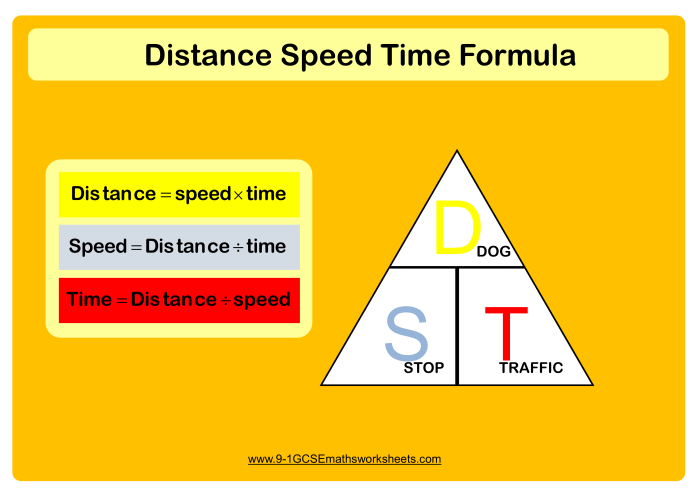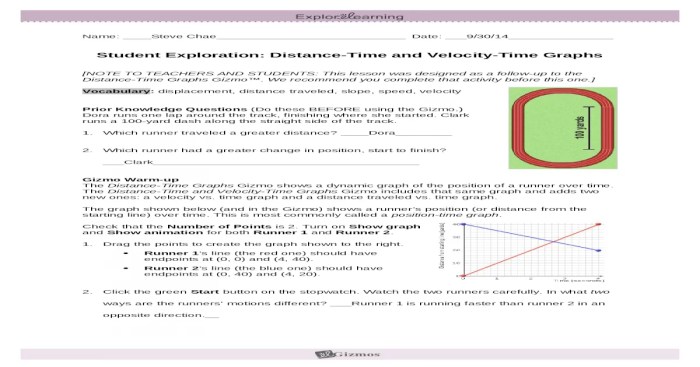Delving into the realm of physics, the distance time and velocity time graphs gizmo answer key serves as an invaluable tool for deciphering the intricate dance of motion. These graphs provide a visual representation of an object’s journey through space and time, offering insights into its displacement, velocity, and acceleration.
Distance-time graphs chronicle the object’s position over time, while velocity-time graphs capture the rate of change in its position. By analyzing these graphs, we can determine whether the object is moving at a constant speed, accelerating, or decelerating. The relationship between these two graphs allows us to derive valuable information about the object’s motion, making them indispensable tools for understanding the dynamics of the physical world.
Distance-Time Graphs

Distance-time graphs are graphical representations that show the relationship between the distance traveled by an object and the time taken to cover that distance. They provide a visual representation of the object’s motion.
Different types of motion can be represented by different types of distance-time graphs:
- Uniform motion:A straight line with a constant slope, indicating that the object is moving at a constant speed.
- Accelerated motion:A curved line that is concave upwards, indicating that the object is accelerating.
- Decelerated motion:A curved line that is concave downwards, indicating that the object is decelerating.
Distance-time graphs can be used to determine the object’s motion. The slope of the graph represents the object’s speed. The area under the graph represents the total distance traveled by the object.
Velocity-Time Graphs: Distance Time And Velocity Time Graphs Gizmo Answer Key
Velocity-time graphs are graphical representations that show the relationship between the velocity of an object and the time taken. Velocity is the rate of change of displacement. Velocity-time graphs provide a visual representation of the object’s motion.
Different types of motion can be represented by different types of velocity-time graphs:
- Uniform motion:A straight line parallel to the time axis, indicating that the object is moving at a constant velocity.
- Accelerated motion:A straight line that is sloping upwards, indicating that the object is accelerating.
- Decelerated motion:A straight line that is sloping downwards, indicating that the object is decelerating.
Velocity-time graphs can be used to determine the object’s velocity and acceleration. The slope of the graph represents the object’s acceleration. The area under the graph represents the total displacement of the object.
Relationship between Distance-Time and Velocity-Time Graphs

Distance-time and velocity-time graphs are related to each other. The slope of the distance-time graph is equal to the velocity-time graph. The area under the velocity-time graph is equal to the distance-time graph.
This relationship can be used to derive distance-time graphs from velocity-time graphs, and vice versa. For example, if you know the velocity-time graph of an object, you can find the distance-time graph by integrating the velocity-time graph.
Gizmo Answer Key
| Question | Answer | Reasoning |
|---|---|---|
| 1. What is the slope of the distance-time graph for an object moving at a constant speed? | Constant | The slope of a distance-time graph represents the object’s speed. If the object is moving at a constant speed, then the slope will be constant. |
| 2. What is the shape of the velocity-time graph for an object that is accelerating? | Straight line sloping upwards | The slope of a velocity-time graph represents the object’s acceleration. If the object is accelerating, then the slope will be positive and the graph will be a straight line sloping upwards. |
| 3. How can you use a velocity-time graph to find the total displacement of an object? | Integrate the velocity-time graph | The area under a velocity-time graph represents the total displacement of the object. To find the total displacement, you need to integrate the velocity-time graph. |
General Inquiries
What is the difference between a distance-time graph and a velocity-time graph?
A distance-time graph shows the distance traveled by an object over time, while a velocity-time graph shows the rate of change of distance over time.
How can I use a velocity-time graph to determine the acceleration of an object?
The acceleration of an object is equal to the slope of its velocity-time graph.
What does a horizontal line on a distance-time graph indicate?
A horizontal line on a distance-time graph indicates that the object is not moving.
